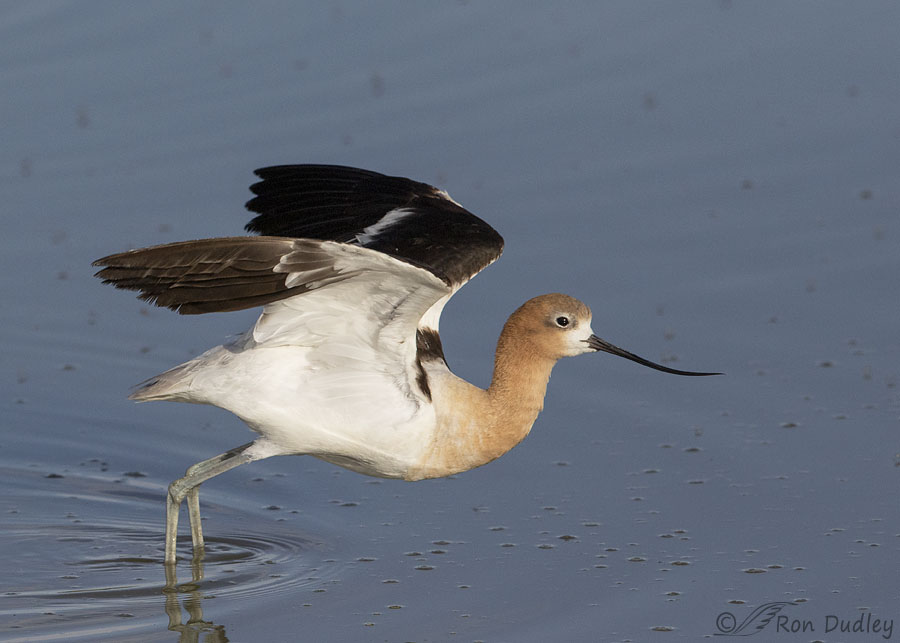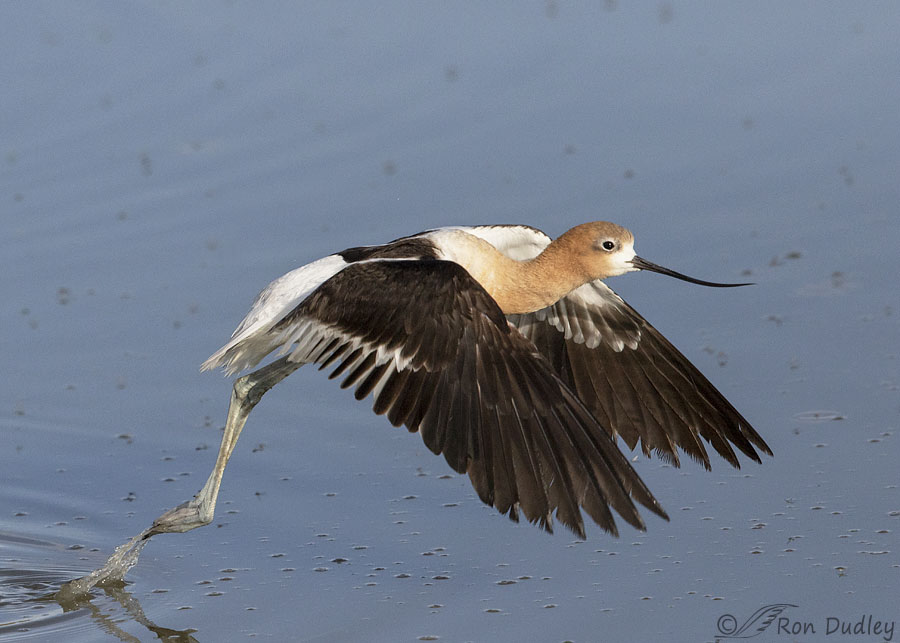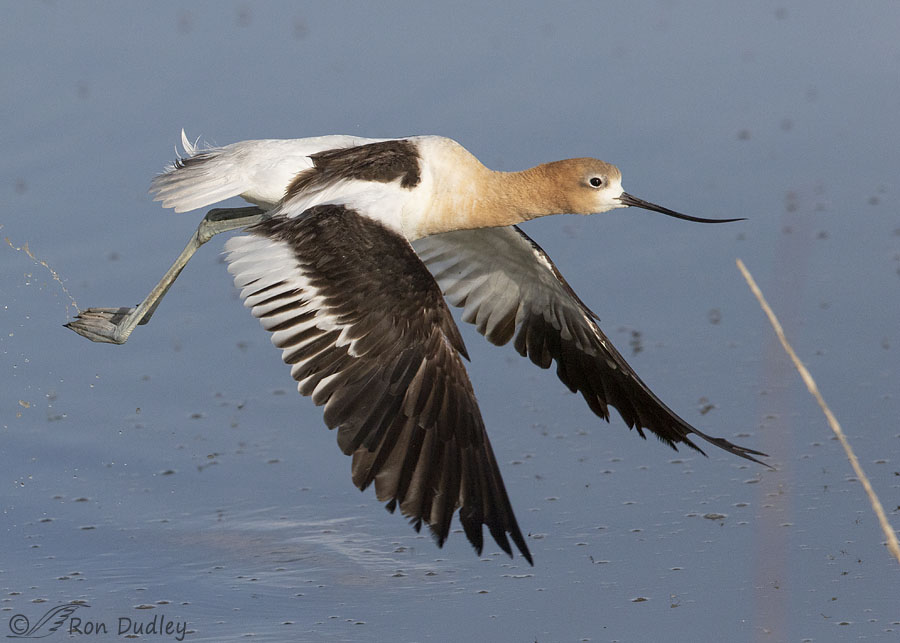Getting three takeoff shots in a series like this is pretty unusual for me, especially since I didn’t clip any body parts. Yesterday was mostly a good day at Bear River MBR but I saw some very disturbing conditions while I was there.

1/8000, f/6.3, ISO 800, Canon 7D Mark II, Canon EF 500mm f/4L IS II USM + EF 1.4 III Extender, not baited, set up or called in
I had stopped for a group of avocets mostly because there was a couple of chicks among them I wanted to photograph but in the end it was my photos of this adult taking off that I was most pleased with, in part because of their degree of difficulty. Thankfully I had already removed my teleconverter when it took off because otherwise I’d have had no chance to avoid clipping or cutting off body parts.
These three photos are sequential shots in a burst with no skips.

1/8000, f/6.3, ISO 800, Canon 7D Mark II, Canon EF 500mm f/4L IS II USM + EF 1.4 III Extender, not baited, set up or called in
This is my favorite shot in the short series. In particular I like the wing position, the water column being pulled up and forward by the feet and the sharpness of the entire bird. My ridiculously fast shutter speed contributed to the wing sharpness of course but I was still pleasantly surprised to have enough depth of field to get both wings sharp considering how close I was to the bird and my aperture of f/6.3.

1/8000, f/6.3, ISO 800, Canon 7D Mark II, Canon EF 500mm f/4L IS II USM + EF 1.4 III Extender, not baited, set up or called in
In some ways this is my luckiest shot of the series even though I like the previous photo better. As you can see by the vegetation that now appears in the frame at right I was panning (moving the camera/lens horizontally) when I took this shot and I was still able to keep the entire bird in the frame and maintain its sharpness. More often than not in this situation I’ll clip body parts or lose sharp focus on the bird. Or both.
I’m not particularly happy with the vegetation in front of the bird in the last shot or all the bubbles on the water surface that appear as dark blobs in the top half of the frame but I can live with them. What I couldn’t live with was the tip of a twig sticking out of the water directly behind the bird in the first two shots so I removed them. I rarely make those kinds of alterations to my images but when I do I always disclose what I’ve done.
I used the caveat “mostly” in my opening paragraph for a reason. Yesterday was largely a good day at the refuge. I had several opportunities with birds in flight and I photographed chicks and juveniles of several species but I was deeply concerned by the conditions I saw at the refuge. Even though we’ve had a banner water year so far here in northern Utah the refuge was almost as dry as a bone in many areas resulting in far fewer birds than usual this time of year, in part because of fewer nesting opportunities for birds. Agriculture and industry upstream on the Bear River are using so much water there isn’t enough left for the refuge. And the state of Utah, in their infinite wisdom, is moving forward with plans for more dams on the upper Bear River which will prevent even more water from reaching the refuge in the future.
Much of the refuge today looks more like a large ranch than it does a bird refuge. Cows on the refuge are controlled by many miles of electric fence and large impoundments are dry and growing vegetation where birds used to nest and feed in and on the water.
What I saw yesterday was deeply disturbing. I’m afraid that “Bear River Ranch” is becoming a more appropriate name for the refuge than Bear River Migratory Bird Refuge.
Ron


Hmm. I know of a previously large lake in this area that was shallow wetland that have dried up due to use for irrigation. Now the migration route has changed. It is sad to witness and I wonder if the water levels will rise with all the rain we are getting. I love the water funneling off the feet of the Avocet the best.
LOVE the photos.
My heart aches for the refuge though. Our own guvermint has a nasty tendency to put industry and jobs ahead of the environment (a known polluter has been given a pass to establish a coal mine near the Great Barrier Reef). I suspect they will learn the error of their ways – too late. I do hope yours are faster learners.
“I do hope yours are faster learners.”
Not a chance, EC. They don’t come much slower than ours.
Great series!
I too was concerned for the 3rd year in a row they dried up pond 2 during nesting season. When I inquired about it, I was also told for phragmite control, which was part of the reason last year pond 2 was drained and cattle allowed to graze. The cattle ate so much phrag and reeds the area was a completely different looking habitat this spring. When I stated the pond was drained so late into nesting and I was concerned about nesting grebes who need water to take off and raise young until they can fly, I was told there are other nesting locations on the refuge where there is water and nesting for the grebes. There was ample water this spring, why did they drain it all off? Do the ponds need a constant inflow to remain stable? Isn’t that why the dikes system was built to retain the run off and create more wetland?
I wish they would publicize their plans for the refuge.
“I wish they would publicize their plans for the refuge.”
Exactly, April. Exactly!
Two years ago they did say (on their FB page) that they drained unit 2 for construction purposes. But then they changed their minds about doing the construction that year so there was one year down the drain (literally) for nesting birds for no reason. So the following year they drained it again and finally did the construction but a second year was lost for nesting birds. This year they’ve apparently drained it a third time (or there isn’t enough water or both) supposedly for phrag control. But then why would they tell my friend the reason for it being dry was because they weren’t getting enough water? Besides, last year they burned that entire huge area absolutely beyond recognition and they’re going to do it again this year? When will this stop? When there aren’t enough birds left to utilize good habitat if they can find it? I dunno, something seems fishy to me. And not very well planned or organized…
And I strongly dislike their response to your question when they said “there are other nesting locations on the refuge where there is water and nesting for the grebes”. Under that misguided philosophy why not get rid of the refuge altogether? After all, there are other nesting locations they can use…
Ron,
I have felt the same way for the few years that I have been going up to Bear River after reading and following your blog. I thought that someday you would comment and explain. Thanks.
As always, beautiful shot. The Avocet was the first bird I photographed when I started out on the way to Tooele. Lovely coloring.
Stephen
Thanks, Stephen. Avocets were among the first birds I photographed when I took up serious bird photography about 11 years ago. What a great beginning subject they are.
There’s at least two advocacy communities in which birders must raise strong voices in the effort to minimize habitat and consequent avian species loss. The first is, obviously, birding preservation work. The second, less obvious one, is water rights advocacy. And–as you so clearly underscore here–it is critical to think in terms of entire watersheds and ALL users of a watershed–not just humans and their agriculture. It is not be enough to advocate for one’s downstream refuge or riparian restoration project or what have you without taking into account what’s going on upstream. But be prepared if you’ve not entered this weed patch before. Water rights law is among the most complicated and convoluted legal thickets one can imagine. Though Mark Twain never actually said what is inaccurately attributed to him, it is true: Whiskey is for drinking. Water is for fighting.
Whoever said it, it’s on the mark – at least here in the dry west. Thanks for jumping in, Jim.
Last year when I visited Bear River MBR much of it was drained, so in May of this year I contacted the Refuge headquarters about conditions and received this reply:
“Hi John – Thank you for asking! The big pond that you are referring to, Unit 2D is actually being drained in preparation for a cattle grazing project for the management of phragmites this summer. Please call me if you would like to discuss.”
I have no idea on the best way to manage phragmites, but I decided to skip my annual trip to one of my favorite places this year. On the bright side, I found a place closer to home (Washington State) that I like almost as much as Bear River.
John, what’s REALLY going on out there is so hard to figure out, in part because of conflicting information and the refuge being less than forthcoming on places like their Facebook page. Here’s what I wrote on FB in response to Jeff Strong who made a similar observation about my post on Facebook:
“I figured I might be hearing from you on this one, Jeff. A reliable friend of mine told me yesterday that he visited refuge headquarters and asked them why the refuge was so dry. The answer he got was “because we’re not getting enough water”. And this is the third year in a row that area of the refuge has been dry. The first year the refuge said it was because of maintenance and construction but after that they changed their minds and didn’t do the construction until last year so it had to be dry again. And now it’s dry for a third year. If it’s “on purpose” seems to me the so-called solution may be worse for birds than the phrags. Something in all this just has a fishy smell and I don’t mean from all the dead carp…”
Neat the way he’s leaning in for the takeoff in the first photo.
Primaries are looking kinda ragged; molt soon?
Disturbing to hear about the refuge. Same story everywhere, it seems. Too many of us, not enough birds.
I think so, Lyle. Here’s part of what Cornell’s BNA Online has to say about their molt.
“Complete definitive prebasic molt, primarily Jul–Oct in North America”.
Beautiful shots, I personally like the second one even though the stick in the last one doesn’t really bother me. Sorry, just my opinion.
Shame about the refuge, but I’m afraid what we as a country are headed for and I’m less than optimistic, but not quite pessimistic yet.
It is a slow grinding process to educate and show people the advantages of saving land for wildlife so that future generations have the benefit of that enjoyment.
Never feel the need to apologize for your honest opinion, Dick. Thanks.
Beautiful series…love the sharpness.These are such an interesting bird. I hope you post some of those ‘youngster’ photos in the near future. Sadly I fear when many people are elected and turned into politicians they lose sight of the big picture and join the ‘good old boys club’.Sadly for so very many, nature preservation of any sort is at the bottom of the list.
Yes, rest assured that you’ll be seeing some youngsters soon. Thanks, Kathy.
I like these.
Good.
We drove thru the Salt Lake area yesterday on our way to s. Cal to deal with some house issues. I can’t believe the growth going on, both commercial, office space, and residential. We are also seeing it in Bozeman. It’s crazy. That’s no excuse for robbing water from the refuge. There should be plenty to share considering the bounty wet year. What’s with the growth however. We think it’s the working folks fleeing California.
Great shots of one of my favorite birds.
Thanks, Frank. Whenever our Utah politicians see dollar signs it’s a foregone conclusion they’ll choose unchecked growth over wise management. It never fails. Not ever.
Gorgeous shots, Ron……. Great when it all comes together…..:) Being able to have enough depth of field to keep the whole bird sharp as well as shutter speed to stop the motion is quite the challenge
Great when it all comes together…..:) Being able to have enough depth of field to keep the whole bird sharp as well as shutter speed to stop the motion is quite the challenge  It is a shame about the Refuge suffering due to ag use – there has to be a balance but the almighty $$$ always seems to prevail
It is a shame about the Refuge suffering due to ag use – there has to be a balance but the almighty $$$ always seems to prevail  Utah seems to be hell bent on growth and getting water by whatever means necessary regardless of the cost to some/others….. Of course, not just Utah involved in that kind of behavior. We’ve had some Avocets in a prairie pothole on the way to town still – must have chicks somewhere and they’d better mature fast along with some ducklings in other areas as the thermostat has been turned up (90 today and forward) and they will shrink to nothing fast unless there is a gully washer along the line…..
Utah seems to be hell bent on growth and getting water by whatever means necessary regardless of the cost to some/others….. Of course, not just Utah involved in that kind of behavior. We’ve had some Avocets in a prairie pothole on the way to town still – must have chicks somewhere and they’d better mature fast along with some ducklings in other areas as the thermostat has been turned up (90 today and forward) and they will shrink to nothing fast unless there is a gully washer along the line…..
Thanks, Judy. I remember how fast those potholes up there dry up. We didn’t have them on the farm but there was a bunch of them elsewhere on the Blackfoot Reservation and they usually wouldn’t last long.
Fantastic series Ron!
Charlotte
Thanks, Charlotte.
That’s a shame about the conditions and what is happening there at the refuge, but the photos themselves are beautiful. I have always really liked seeing American Avocets when they visit here, but unfortunately there are many years when they do not show up. I agree that photo #2 is the best although all three are very good. The wings in particular really stand out. Great job Ron.
Thank you, Everett. I’m not optimistic about the future of Bear River MBR.